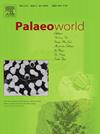The first fossil species of Trichopria Ashmead, 1893 (Hymenoptera: Diapriidae) from the Miocene Zhangpu biota
IF 1.7
3区 地球科学
Q2 PALEONTOLOGY
引用次数: 0
Abstract
Following studies of the aculeate families Bethylidae, Chrysididae, Formicidae, and Apidae, we report here the Diapriidae, the fifth hymenopteran family from the middle Miocene Zhangpu amber of China. A fossil species belonging to Trichopria Ashmead, 1893 is described and figured from a male specimen. The new extinct species, Trichopria electrosinica n. sp., is characterized by the subround and hypognathous head, the flagellomeres each with 6–8 long setae, the metanotum with longitudinal keels, the petiole two times longer than wide and carinate, and the fore basitarsomere with a row of setae along the inner margin. Trichopria is one of the largest diapriid genus, with some species used in pest control program against fruit flies, but Trichopria electrosinica n. sp. is its first described fossil species. Its absence in older and long-known deposits is indicative of the disparate Diapriidae fossil record. Its occurrence in both China and Dominican Republic during the Miocene suggests that the genus was already widespread at that time.
张浦中新世毛蜂属第一化石种,1893(膜翅目:茧蜂科)
本文报道了中国中中新世张浦琥珀中膜翅目昆虫的第5个膜翅目昆虫,即茧蜂科、茧蜂科、蚁蜂科。描述了1893年属于Trichopria Ashmead的一个化石物种,并从一个雄性标本中绘制了图形。新绝种电毛缕虫的特征是:头部呈圆形和下颚状,鞭毛节各有6-8根长刚毛,叶柄纵龙骨,叶柄宽2倍,呈肉状,前基体沿内缘有一排刚毛。毛缕虫是最大的双阿匹利属之一,有一些品种用于防治果蝇,但电毛缕虫是其第一个被描述的化石种。在更古老的和长期已知的沉积物中,它的缺失表明了不同的Diapriidae化石记录。中新世在中国和多米尼加共和国的出现表明该属在当时已经很普遍了。
本文章由计算机程序翻译,如有差异,请以英文原文为准。
求助全文
约1分钟内获得全文
求助全文
来源期刊

Palaeoworld
PALEONTOLOGY-
CiteScore
4.00
自引率
5.90%
发文量
95
期刊介绍:
Palaeoworld is a peer-reviewed quarterly journal dedicated to the study of past life and its environment. We encourage submission of original manuscripts on all aspects of palaeontology and stratigraphy, comparisons of regional and global data in time and space, and results generated by interdisciplinary investigations in related fields. Some issues will be devoted entirely to a special theme whereas others will be composed of contributed articles. Palaeoworld is dedicated to serving a broad spectrum of geoscientists and palaeobiologists as well as serving as a resource for students in fields as diverse as palaeobiology, evolutionary biology, taxonomy and phylogeny, geobiology, historical geology, and palaeoenvironment.
Palaeoworld publishes original articles in the following areas:
•Phylogeny and taxonomic studies of all fossil groups
•Biostratigraphy, chemostratigraphy, chronostratigraphy
•Palaeoecology, palaeoenvironment and global changes throughout Earth history
•Tempo and mode of biological evolution
•Biological events in Earth history (e.g., extinctions, radiations)
•Ecosystem evolution
•Geobiology and molecular palaeobiology
•Palaeontological and stratigraphic methods
•Interdisciplinary studies focusing on fossils and strata
 求助内容:
求助内容: 应助结果提醒方式:
应助结果提醒方式:


